Film historian and EFSP contributor is still in Rome and today he gives a paper on the classic epic Cabiria (1914), which was the summit of the early Italian Antiquity films. Sadly, there are no postcards of this silent film, but there are many cards of its female star, Italia Almirante (1890-1941). With Cabiria, she became one of the divas of the Italian silent cinema, and worked with some of the most important Italian directors of the silent era, including Roberto Roberti, Augusto Genina and Giovanni Pastrone. From 1935 on she played on stage in Brazil, where she suddenly died when she was bitten by a poisonous insect.
Image may be NSFW.
Clik here to view.
Still from Cabiria (1914).
Image may be NSFW.
Clik here to view.
Italian postcard by G.B. Falci, Milano, no. 14.
Image may be NSFW.
Clik here to view.
Italian postcard by Neg. Vettori, Bologna, no. 1031.
Image may be NSFW.
Clik here to view.
Italian postcard by Ed. Traldi, Milano, no. 528.
Image may be NSFW.
Clik here to view.
Italian postcard by Casa Editrice Ballerini e Fratini, Firenze, no. 31. Photo: Alba Film. Publicity still for L'ombra/The Shadow (Mario Almirante, 1923).
Italia Almirante was born in Taranto, Italy, in 1890. She was born into a family of theatre artists. Her father was the actor Michele Almirante, and her mother the actress Urania Dell'Este. One of her cousins was film actor Luigi Almirante.
Italia also began to appear on stage and in 1911 she made her film debut for the Cines studio in Rome, where she played the lead in Gerusalemme liberata/The Crusaders (Enrico Guazzoni, 1911) and San Francesco. Il poverello di Assisi/Saint Francis: The Poor Boy from Assisi (Enrico Guazzoni, 1911), both opposite Emilio Ghione.
She moved over to another pioneer film studio, Savoia Film in Turin. There she appeared in Sul sentiero della vipera/On the Trail of the Viper (Oreste Mentasti, 1912).
Two years later she had her breakthrough as the wicked Carthaginian queen Sofonisba in the influential costume epic Cabiria (1914). Director Giovanni Pastrone chose her for the role at the suggestion of author Gabriele D'Annunzio himself.
A million lira was budgeted for the film, a tremendous sum then, and location shooting was extended to Tunisia, Sicily and the Alps. The result was a tremendous success and it had a direct influence on D.W. Griffith's production of Intolerance (1916).
Image may be NSFW.
Clik here to view.
Italian postcard.
Image may be NSFW.
Clik here to view.
Italian postcard by Ed. Ballerini & Fratini, Firenze. Photo: Fot. Scoffone, no. 521.
Image may be NSFW.
Clik here to view.
Italian postcar by Ed. A. Traldi, Milano, no. 529. Italia Almirante and Gian Paolo Rosmino in the Italian silent film L'ironia della vita (Mario Roncoroni, 1917). The film deals with Paolo who flees to the USA after a stock exchange scandal, leaving behind his wife Elena. After a year, Elena hears he died, so after another year she remarries. But then Paolo returns, having become rich as mine engineer... NB. the card writes Ironia instead of Ironie and Rosmini instead of Rosmino.
Image may be NSFW.
Clik here to view.
Italian postcard by Neg. Vettori, Bologna, no. 15.
Image may be NSFW.
Clik here to view.
Italian postcard by Ballerini & Fratini, Firenze, no. 204. Photo: Scoffone. Publicity still of Italia Almirante Manzini as Violante in the film L'Arzigogolo (Mario Almirante, 1924), an adaptation of the play by Sem Benelli.
In particular between 1917 and 1922 Italia Almirante had an intense film career in Italy. She starred in films like Maternità/Maternity (Ugo de Simone, 1917), Femmina - Femina/Female - Female (Augusto Genina, 1918) and Hedda Gabler (Gero Zambuto, Giovanni Pastrone, 1920), based on the play by Henrik Ibsen.
Opposite Bartolomeo Paganoshe starred in three Maciste-films: Maciste poliziotto (Roberto Roberti, 1918), Maciste atleta (Vincenzo Denizot, Giovanni Pastrone, 1918) and Maciste medium (Vincenzo Denizot, 1918). The popular Maciste series presented the historical adventures of the strongman Maciste, who was introduced in Cabiria (1914).
When Italia married journalist/actor Amerigo Manzini in 1919 she also became known as Italia Almirante Manzini.
She was a cousin of film director Mario Almirante who directed her in nine films between 1920 and 1926, including Zingari (1920) with Amleto Novelli and La statua di carne/The Statue of Flesh (1921) and L'ombra/The Shadow (1923).
She also worked frequently with prolific directors like Augusto Genina (e.g. I due crocefissi/The Two Crucifixes (1920)) and Gennaro Righelli (e.g. Il sogno d'amore/The Dream of Love (1922)).
Image may be NSFW.
Clik here to view.![Italia Almirante]()
Italian postcard by Ed. A. Traldi, Milano, no. 540.
Image may be NSFW.
Clik here to view.![Italia Almirante]()
Italian postcard by Neg. Scofione, no. 347.
Image may be NSFW.
Clik here to view.![La statua di carne]()
Italian postcard by Fotominio. Photo: G.B. Falci, Milano. Italia Almirante in La statua di carne (Mario Almirante 1921).
Image may be NSFW.
Clik here to view.![Italia Almirante in La statua di carne (1921)]()
Italian postcard by Fotominio, no. 52. Photo: G.B. Falci, Milano. Italia Almirante in La statua di carne (Mario Almirante 1921).
Image may be NSFW.
Clik here to view.![Italia Almirante]()
Italian postcard by Ballerini & Fratini, Firenze, no. 529. Photo: Scoffone. Publicity still for L'Arzigogolo/The Fantasy (Mario Almirante, 1924).
In 1924 Italia Almirante Manzini played in a film adaptation of a play by Italian autor Sem Benelli, L'Arzigogolo/The Fantasy (Mario Almirante, 1924).
Almirante played Monna Violante, wed by her father to the rich merchant Floridoro (Oreste Bilancia), falls in love with Spallatonda (Annibale Betrone), the buffoon of count Giano (Alberto Collo), one of her suitors. After Giano has been killed by the hand of Spallatonda, the latter flees with Monna Violante.
After the mid-1920s she turned to the stage, returning to a film set only one more time, for the film L'Ultimo dei Bergerac/The Last of the Bergerac (Gennaro Righelli, 1934) with Livio Pavanelli. It would be her only sound film.
In 1935 she went on a stage tour across Brazil, and decided to stay there. In 1941 Italia Almirante Manzini suddenly died in São Paulo. The cause was a poisonous insect. She was only 51.
Recently, a book about the Almirante family was presented, Da Pasquale a Giorgio Almirante. Storia di una famiglia d’arte (Marsilio, 2016), written by one of the descendants of the family, Pasquale Almirante.
Image may be NSFW.
Clik here to view.![La chiromante]()
Italian postcard, no. 40. Photo: Società cinematografica FERT. Publicity still for La chiromante aka La maschera del male (Mario Almirante, 1922), starring Italia Almirante Manzini, Lido Manetti and Oreste Bilancia. Caption: At the horse races, meeting of the countess Turchina and the three inseparable friends.
Image may be NSFW.
Clik here to view.![Italia Almirante in La grande passione]()
Italian postcard. Photo: Società cinematografica FERT. Publicity still for La grande passione (Mario Almirante, 1922), starring Italia Almirante Manzini and André Habay. Caption: Joint life in their retreat.
Image may be NSFW.
Clik here to view.![Italia Almirante]()
Italia Almirante and Alberto Collo. Italian postcard by G.B. Salci, Milano. Photo: publicity still for L'Arzigogolo/The Fantasy (Mario Almirante, 1924).
Image may be NSFW.
Clik here to view.![Italia Almirante in L'amorosa tragedia]()
Italian postcard. Photo: Crimella. Italia Almirante in the Italian stage play L'amorosa tragedia (1925) by Sem Benelli and directed by Luigi Almirante. The play was staged by Almirante's own stage company. A young Vittorio De Sicaacted in this play as well.
Image may be NSFW.
Clik here to view.![Italia Almirante Manzini]()
Italian postcard by Fotocelere, Torino.
Sources: Vittorio Martinelli (Le dive del silenzio - Italian), Facebook (Italian), Wikipedia (Italian) and IMDb.
Image may be NSFW.
Clik here to view.

Still from Cabiria (1914).
Image may be NSFW.
Clik here to view.
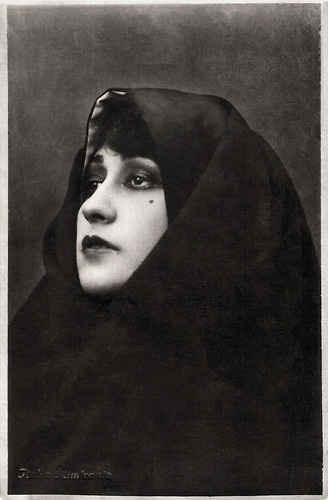
Italian postcard by G.B. Falci, Milano, no. 14.
Image may be NSFW.
Clik here to view.

Italian postcard by Neg. Vettori, Bologna, no. 1031.
Image may be NSFW.
Clik here to view.
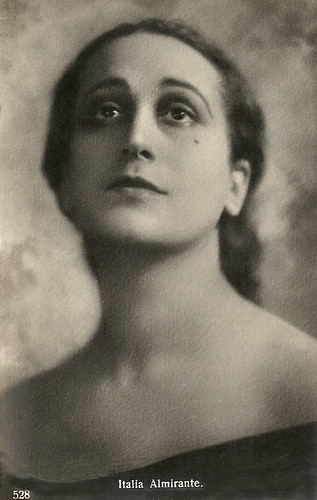
Italian postcard by Ed. Traldi, Milano, no. 528.
Image may be NSFW.
Clik here to view.
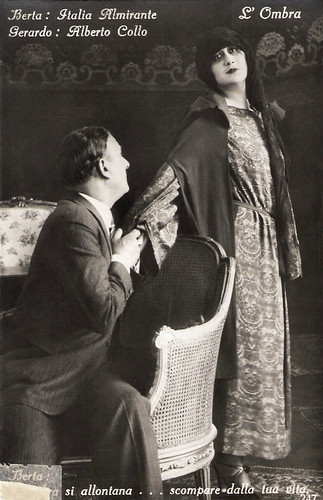
Italian postcard by Casa Editrice Ballerini e Fratini, Firenze, no. 31. Photo: Alba Film. Publicity still for L'ombra/The Shadow (Mario Almirante, 1923).
Cabiria
Italia Almirante was born in Taranto, Italy, in 1890. She was born into a family of theatre artists. Her father was the actor Michele Almirante, and her mother the actress Urania Dell'Este. One of her cousins was film actor Luigi Almirante.
Italia also began to appear on stage and in 1911 she made her film debut for the Cines studio in Rome, where she played the lead in Gerusalemme liberata/The Crusaders (Enrico Guazzoni, 1911) and San Francesco. Il poverello di Assisi/Saint Francis: The Poor Boy from Assisi (Enrico Guazzoni, 1911), both opposite Emilio Ghione.
She moved over to another pioneer film studio, Savoia Film in Turin. There she appeared in Sul sentiero della vipera/On the Trail of the Viper (Oreste Mentasti, 1912).
Two years later she had her breakthrough as the wicked Carthaginian queen Sofonisba in the influential costume epic Cabiria (1914). Director Giovanni Pastrone chose her for the role at the suggestion of author Gabriele D'Annunzio himself.
A million lira was budgeted for the film, a tremendous sum then, and location shooting was extended to Tunisia, Sicily and the Alps. The result was a tremendous success and it had a direct influence on D.W. Griffith's production of Intolerance (1916).
Image may be NSFW.
Clik here to view.
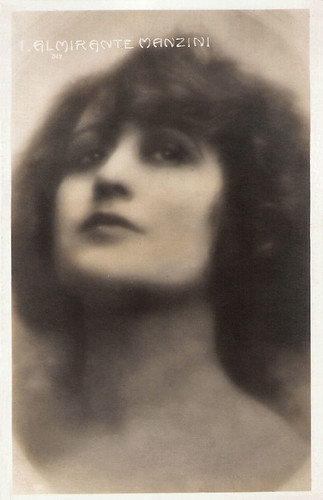
Italian postcard.
Image may be NSFW.
Clik here to view.
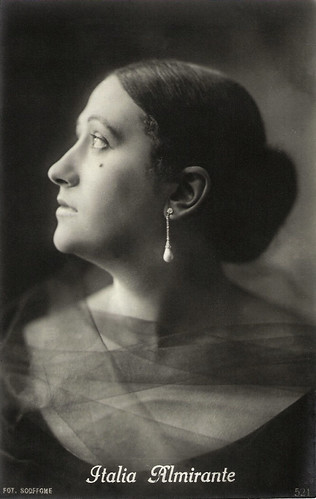
Italian postcard by Ed. Ballerini & Fratini, Firenze. Photo: Fot. Scoffone, no. 521.
Image may be NSFW.
Clik here to view.
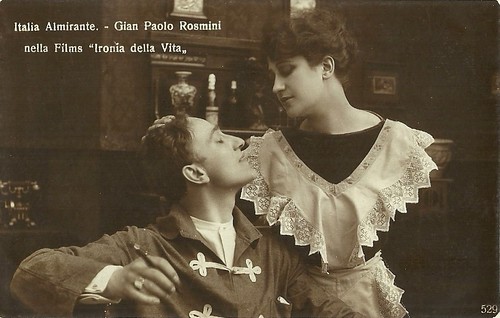
Italian postcar by Ed. A. Traldi, Milano, no. 529. Italia Almirante and Gian Paolo Rosmino in the Italian silent film L'ironia della vita (Mario Roncoroni, 1917). The film deals with Paolo who flees to the USA after a stock exchange scandal, leaving behind his wife Elena. After a year, Elena hears he died, so after another year she remarries. But then Paolo returns, having become rich as mine engineer... NB. the card writes Ironia instead of Ironie and Rosmini instead of Rosmino.
Image may be NSFW.
Clik here to view.
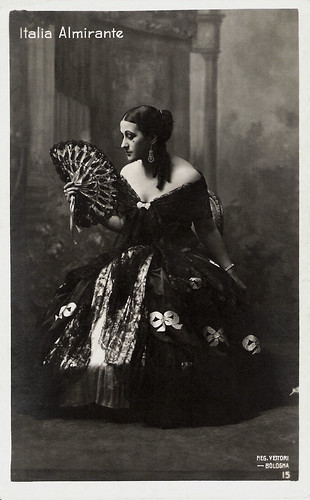
Italian postcard by Neg. Vettori, Bologna, no. 15.
Image may be NSFW.
Clik here to view.

Italian postcard by Ballerini & Fratini, Firenze, no. 204. Photo: Scoffone. Publicity still of Italia Almirante Manzini as Violante in the film L'Arzigogolo (Mario Almirante, 1924), an adaptation of the play by Sem Benelli.
Intense Film Career
In particular between 1917 and 1922 Italia Almirante had an intense film career in Italy. She starred in films like Maternità/Maternity (Ugo de Simone, 1917), Femmina - Femina/Female - Female (Augusto Genina, 1918) and Hedda Gabler (Gero Zambuto, Giovanni Pastrone, 1920), based on the play by Henrik Ibsen.
Opposite Bartolomeo Paganoshe starred in three Maciste-films: Maciste poliziotto (Roberto Roberti, 1918), Maciste atleta (Vincenzo Denizot, Giovanni Pastrone, 1918) and Maciste medium (Vincenzo Denizot, 1918). The popular Maciste series presented the historical adventures of the strongman Maciste, who was introduced in Cabiria (1914).
When Italia married journalist/actor Amerigo Manzini in 1919 she also became known as Italia Almirante Manzini.
She was a cousin of film director Mario Almirante who directed her in nine films between 1920 and 1926, including Zingari (1920) with Amleto Novelli and La statua di carne/The Statue of Flesh (1921) and L'ombra/The Shadow (1923).
She also worked frequently with prolific directors like Augusto Genina (e.g. I due crocefissi/The Two Crucifixes (1920)) and Gennaro Righelli (e.g. Il sogno d'amore/The Dream of Love (1922)).
Image may be NSFW.
Clik here to view.

Italian postcard by Ed. A. Traldi, Milano, no. 540.
Image may be NSFW.
Clik here to view.

Italian postcard by Neg. Scofione, no. 347.
Image may be NSFW.
Clik here to view.

Italian postcard by Fotominio. Photo: G.B. Falci, Milano. Italia Almirante in La statua di carne (Mario Almirante 1921).
Image may be NSFW.
Clik here to view.

Italian postcard by Fotominio, no. 52. Photo: G.B. Falci, Milano. Italia Almirante in La statua di carne (Mario Almirante 1921).
Image may be NSFW.
Clik here to view.
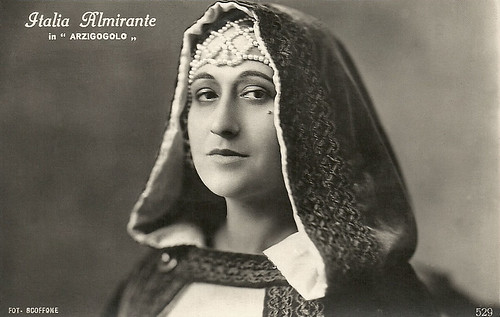
Italian postcard by Ballerini & Fratini, Firenze, no. 529. Photo: Scoffone. Publicity still for L'Arzigogolo/The Fantasy (Mario Almirante, 1924).
Poisonous Insect
In 1924 Italia Almirante Manzini played in a film adaptation of a play by Italian autor Sem Benelli, L'Arzigogolo/The Fantasy (Mario Almirante, 1924).
Almirante played Monna Violante, wed by her father to the rich merchant Floridoro (Oreste Bilancia), falls in love with Spallatonda (Annibale Betrone), the buffoon of count Giano (Alberto Collo), one of her suitors. After Giano has been killed by the hand of Spallatonda, the latter flees with Monna Violante.
After the mid-1920s she turned to the stage, returning to a film set only one more time, for the film L'Ultimo dei Bergerac/The Last of the Bergerac (Gennaro Righelli, 1934) with Livio Pavanelli. It would be her only sound film.
In 1935 she went on a stage tour across Brazil, and decided to stay there. In 1941 Italia Almirante Manzini suddenly died in São Paulo. The cause was a poisonous insect. She was only 51.
Recently, a book about the Almirante family was presented, Da Pasquale a Giorgio Almirante. Storia di una famiglia d’arte (Marsilio, 2016), written by one of the descendants of the family, Pasquale Almirante.
Image may be NSFW.
Clik here to view.
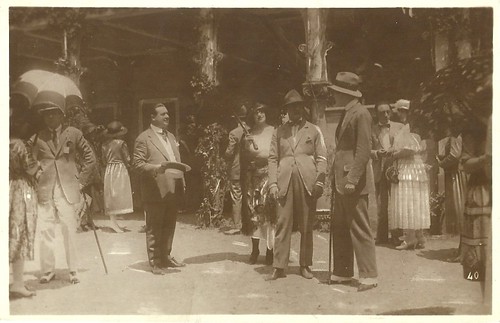
Italian postcard, no. 40. Photo: Società cinematografica FERT. Publicity still for La chiromante aka La maschera del male (Mario Almirante, 1922), starring Italia Almirante Manzini, Lido Manetti and Oreste Bilancia. Caption: At the horse races, meeting of the countess Turchina and the three inseparable friends.
Image may be NSFW.
Clik here to view.
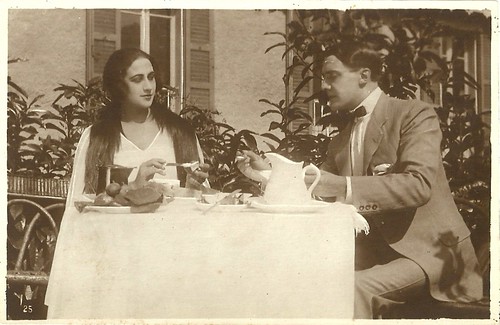
Italian postcard. Photo: Società cinematografica FERT. Publicity still for La grande passione (Mario Almirante, 1922), starring Italia Almirante Manzini and André Habay. Caption: Joint life in their retreat.
Image may be NSFW.
Clik here to view.
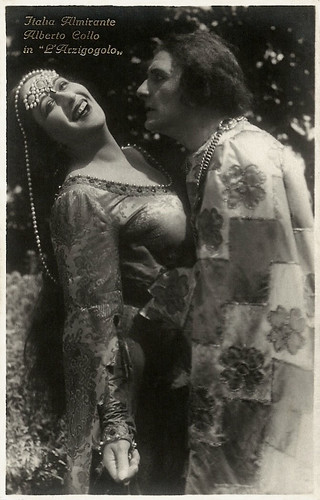
Italia Almirante and Alberto Collo. Italian postcard by G.B. Salci, Milano. Photo: publicity still for L'Arzigogolo/The Fantasy (Mario Almirante, 1924).
Image may be NSFW.
Clik here to view.
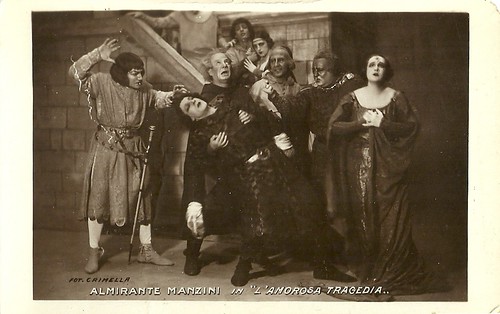
Italian postcard. Photo: Crimella. Italia Almirante in the Italian stage play L'amorosa tragedia (1925) by Sem Benelli and directed by Luigi Almirante. The play was staged by Almirante's own stage company. A young Vittorio De Sicaacted in this play as well.
Image may be NSFW.
Clik here to view.

Italian postcard by Fotocelere, Torino.
Sources: Vittorio Martinelli (Le dive del silenzio - Italian), Facebook (Italian), Wikipedia (Italian) and IMDb.